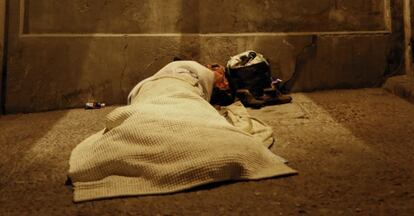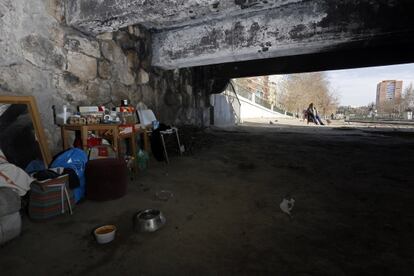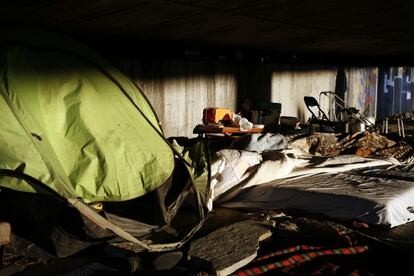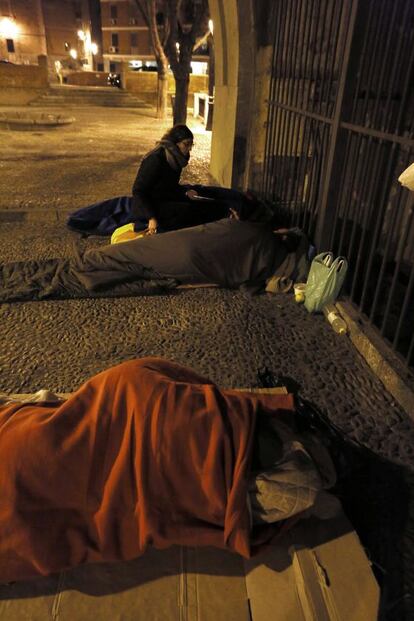When the sky is the roof over your head
Around 700 of Madrid’s 2,200 homeless refuse to use city shelters Raquel, who has died aged 44 after living under a bridge for six years, was one of them

(This article is dedicated to Raquel.)
She was 44, and from Madrid. Six years ago she found shelter under one of the city’s most beautiful bridges, the Puente de la Reina, which crosses the Manzanares river right near the San Antonio de la Florida chapel. It became her home, a small tent doubling as a precarious bedroom for herself and her beloved, faithful dog Nica.
Raquel, who suffered from terminal cancer and cirrhosis, died two weeks ago without fulfilling her greatest dream: “To have a door with a lock, that’s all,” she said, in reference to a room or home of her own. She refused to use the city shelters because “there is no freedom there, no privacy.”
Life on the streets had left its mark on her face and body, but it had not managed to wipe away her smile. And it was a smiling Raquel who welcomed EL PAÍS into her home under the bridge just five days before she died.
Raquel was one of around 700 homeless men and women who live on the streets of Madrid by choice, refusing to use the city’s network of shelters. Around 48 percent of them are Spanish, the rest foreigners. In total there are around 2,200 homeless people in Madrid, of whom 80 percent are men in their early forties.
A smiling Raquel welcomed EL PAÍS into her home under the bridge just five days before she died
Raquel’s daily routine had lately become even more difficult than usual. The disease kept spreading, sapping her strength and her ability to walk. Towards the end she barely moved away from the river bank that she knew so well.
“Some people bring me food, clothes, also [social service workers from] Samur Social come around.” It was members of this municipal service who convinced her, one day before her death, to let them take her back to hospital.
She tried to keep her place as clean as possible. “I sweep it and keep it neat. When I got here it was a dump,” explained Raquel as she pointed at her cooking utensils, her little barbecue, her books… She really enjoyed reading.
“I used to be a teacher,” she revealed with a hint of pride in her eyes.
Her life took a wrong turn when she and her partner decided to move to Portugal. “He started to hit me and I returned to Spain; a truck driver drove me back,” she recalls.

She had nowhere to go and ended up sleeping on a bench in Atocha. She begged from passers-by, “so I could have enough for me and to buy my dog a can of food.” Raquel would probably like to know that one of the local residents who was fond of her has taken in her beloved Nica.
From Atocha she moved to the Bombilla park until she was kicked out to make way for the local San Antonio de la Florida festivities. “They told us we couldn't be there and that’s how I came to live under the bridge; I’m still here today.”
For the last three years she had been living with her partner, who could not be with her during her last moments because of his troubles with the law.
Besides the neighbors and Samur Social workers, volunteers for the non-profit Solidarios para el Desarrollo visited Raquel Monday through Friday. Members of this organization visit the places where the homeless sleep, talking to them “as equals, to try to break their isolation and help them recover their self-esteem,” explains Jesús Sandín, head of the program.
There’s no trouble. It’s all about respecting one another and not stealing from one another”
It was not long before new people moved into her place under the bridge. Sara, a vivacious 25-year-old from Asturias and her boyfriend Alejandro, a 26-year-old Romanian, unzip another tent they've set up next to Raquel’s. Hers has already been appropriated by two other Romanians. The names are assumed: they ask us not to reveal their real identities because they have relatives and loved ones whom they don't want to know about their situation.
Both Sara and Alejandro have children: she has a six-year-old girl, he has a seven-year-old boy. “They live with our ex-partners. In this situation we cannot keep them with us,” says Sara. The couple say they haven’t found a shelter today. But Carmen García de Pablos, director of the city’s largest shelter, San Isidro, says that everyone who knocks on their door gets one of the 268 available spots.
Alejandro is a baker, but has no legal residency papers. “They were stolen from me and now I’m doing the paperwork again,” he says. He recently slept at one of the additional shelters the city runs during winter, which brings the total number of available spots to 2,021.
The couple wash at the public baths on Embajadores street. A shower costs 50 euro cents. They earn some small change helping cars find a parking spot across from Moncloa clinic, on nearby Valladolid avenue.
“We go in the afternoon because there’s a Romanian guy there in the morning. We all need to make a living,” they explain. Like Raquel used to say, “on the streets, except for the troublemakers, there’s no trouble. It’s all about respecting one another and not stealing from one another, or from anybody else.”

Sara grew up in foster homes. Her mother abandoned her and drugs killed her father. “Maybe that’s why,” she muses. “I've taken courses to be a beautician, a hairdresser, a waitress, even a carpenter, but in the end they were useless.”
The couple don’t know where they’ll go tomorrow, but Sara does know that they need to get off the streets.
Darío Pérez, department head of Samur Social, explains that people are free to do whatever they want and cannot be forced to use a shelter. “Although in most cases it’s not such a free choice,” he adds, noting that people often have personal problems that ultimately lead them to make the decision to sleep out in the open. “But we still work with them in the streets, we deal with their paperwork and apply for them to receive the minimum welfare checks [that they are entitled to]."
The data compiled by city authorities during the last homeless census in December 2012 indicates that 54 percent of the people who don’t use a shelter have been out on the streets for over two years; and 24 percent for under four months.
Joblessness is the reason that pushed 41 percent of homeless people out on to the streets
And the longer a person is out there, the harder it becomes to “reconstruct them both physically and psychologically,” experts say. Since 2006, the year that the first census was conducted, the number of homeless people living on the streets has grown by 12 percent. “And we have to keep in mind that these are estimates, since these people tend to be invisible,” adds Darío Pérez.
Antonio, 27, has fixed his residence under a pedestrian overpass inside the Bombilla park, right by the train tracks. He is very familiar with the commuter train schedules, since the noise is impossible to ignore. Antonio spends some nights out in the open and others at the San Isidro shelter, where he goes for food and a wash. He gets electricity by hooking up to a nearby lamppost and never lets go of his most prized possession: a computer. He says he has been “a rolling stone” for eight years and does not drink or do drugs. He was born in Vigo but spent most of his life in foster homes in Madrid.
“I’ve worked as a bricklayer’s mate, a carpenter, a warehouse worker, a supermarket shelf-stacker and even as a salesman,” he says. But now he is out of a job and all alone.
Joblessness is the reason that pushed 41 percent of homeless people out on to the streets. Another 18 percent said it was lack of money, while the rest attributed it to relationship breakups, not having residency or work papers or addiction. Only three percent said theirs was a voluntary situation.
Carlos (also an assumed name) has been living on one of the side alleys leading into the central Plaza Mayor square for around six years. “It’s so many I can hardly remember,” he says. He is up by eight in the morning, just like the rest of the 20 or so people who seek refuge around this popular tourist destination. This is the time of the day when a municipal cleaning crew sets about tidying the place up. The homeless begin to scatter.

Carlos is 65 and looks very unkempt. He answers questions reluctantly, and carries a newspaper under his arm on his way to breakfast. “I like to be informed,” he explains.
He sleeps on a camping mattress thrown over several layers of cardboard, inside a sleeping bag that he makes warmer with blankets. He talks about the time he worked as a cook in the UK and the languages that he speaks. The Samur Social is helping him apply for pension benefits. Then, with a “that’s enough conversation,” he hobbles away.
Carlos is another one of those people who always refused to use shelters and accept their rules, schedules, lack of space for couples and non-existent privacy.
But when homeless individuals create a relationship with the shelters, however, workers try to help them get ahead, explains García de Pablos, director of the San Isidro center. This includes the possibility of signing up for workshops and courses.
“They’re real fighters, but they have been through so much, sometimes in such a short space of time, that we probably would not be able to deal with it,” she says.
Raquel would agree with that. “When someone looks down their nose at me, I think that if they ended up in my place, they wouldn't be able to stand it for a moment.”
Tu suscripción se está usando en otro dispositivo
¿Quieres añadir otro usuario a tu suscripción?
Si continúas leyendo en este dispositivo, no se podrá leer en el otro.
FlechaTu suscripción se está usando en otro dispositivo y solo puedes acceder a EL PAÍS desde un dispositivo a la vez.
Si quieres compartir tu cuenta, cambia tu suscripción a la modalidad Premium, así podrás añadir otro usuario. Cada uno accederá con su propia cuenta de email, lo que os permitirá personalizar vuestra experiencia en EL PAÍS.
¿Tienes una suscripción de empresa? Accede aquí para contratar más cuentas.
En el caso de no saber quién está usando tu cuenta, te recomendamos cambiar tu contraseña aquí.
Si decides continuar compartiendo tu cuenta, este mensaje se mostrará en tu dispositivo y en el de la otra persona que está usando tu cuenta de forma indefinida, afectando a tu experiencia de lectura. Puedes consultar aquí los términos y condiciones de la suscripción digital.
Últimas noticias
The complicated life of Francesca Albanese: A rising figure in Italy but barred from every bank by Trump’s sanctions
From digital curfews to blocking apps: How technology experts protect their children online
Why the price of coffee has skyrocketed: from Brazilian plantations to specialty coffee houses
Confined to a Cuban hospital: When electricity is a matter of life or death
Most viewed
- Pablo Escobar’s hippos: A serious environmental problem, 40 years on
- Why we lost the habit of sleeping in two segments and how that changed our sense of time
- Trump’s obsession with putting his name on everything is unprecedented in the United States
- Charles Dubouloz, mountaineering star, retires at 36 with a farewell tour inspired by Walter Bonatti
- The Florida Keys tourist paradise is besieged by immigration agents: ‘We’ve never seen anything like this’









































